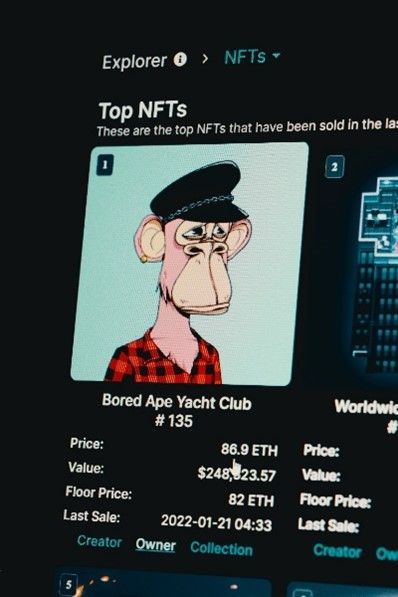We've discussed NFTs (non-fungible tokens) in our articles before, and in the process, we've learned many things, for example:
- The term "non-fungible" means not easily interchangeable;
- An NFT has been described as a unique digital asset that's authenticated using blockchain technology.
- NFTs can comprise of digital artwork, photos, videos, GIFs, music, and concert tickets.
- NFTs are sold on blockchain-backed marketplaces like Opensea and Nifty Gateway, with payment being made by way of cryptocurrency.
- Everyone's invited: we once wrote about a 12-year-old boy who created a series of pixelated artworks called Weird Whales, which he managed to sell for an impressive GBP290 000.

(Niranjan)
IP offices are taking note
For a while, it's felt as though NFTs were completely unregulated. However, two of the major IP offices, the European Intellectual Property Office ("EUIPO") and the US Patent and Trademark Office ("USPTO") are now stepping in and issuing guidelines and undertaking investigations in regard to NFTs.
The European Intellectual Property Office (EUIPO)
The EUIPO released a notification that makes the point that they receive many trade mark applications that seek protection for "virtual goods" and "non-fungible tokens". It says that the office's approach is as follows:
- Virtual goods are classified the same way as digital content or images and classified in class 9 of NICE classification. This shows that it won't be sufficient for a trade mark applicant to file for the term "virtual goods", instead it will need to specify the content to which the virtual goods relate. The office recommends the use of terms like "downloadable virtual goods, namely virtual clothing".
- As for services relating to virtual goods, the EUIPO recommends that these be classified in line with the established principles relating to the classification of services.
The office has invited parties to comment on these suggestions on or before 3 October 2022.
Clarivate discussed this topic at a recent IP forum. During the first of three blog series, the discussion focused on "The Future of IP in the metaverse" and aimed to unfold the IP ownership of the new virtual assets. A few points to note from the discussions:
- At this stage, the primary method of protection is trade marks. However, the challenge is that these virtual assets in the metaverse could be images, video content, and something that is not static.
- Over time, the preferred route of protection may move away from trade marks, and possibly focus on copyright.
- In line with the EUIPO's notification, the forum identified a significant increase in the number of new trade mark applications in class 9, which indicates an interest in the virtual world. The forum also highlighted the fact that NFTs may not "neatly fit" into the current classes of the NICE Classification.
- Lastly, the forum also discussed the monitoring and enforcement of brand owners' rights. They specifically mentioned that brand owners may find it challenging to "takedown" domain names as the virtual world continues to iterate and mature.
US Patent and Trademark Office (USPTO)
The USPTO and the U.S. Copyright Office will undertake a wide-ranging investigation into NFTs. This is on the instruction of the Judiciary sub-committee on Intellectual Property.
The point of the investigation is to reach an understanding of "how NFTs fit into the world of intellectual property rights", including what those rights look like today and how they may evolve in the future. The instruction makes the point that "NFTs are already in global use today and their adoption continues to grow since their relatively recent introduction." It makes the further point that NFTs are already "found in nearly all spheres – from academia to entertainment to medicine, art and beyond".
The brief sets out a non-exhaustive list of issues that the sub-committee feels need consideration. Here are a few:
- What are the current and potential applications of NFTs and their respective IP and IP-related challenges?
- With regards to current and potential future applications of
NFTs:
- How do transfers of rights apply? How does the transfer of an NFT impact the IP rights in the associated asset?
- How do licensing rights apply? If, and how can, IP rights in the associated asset, be licensed in an NFT context?
- In what way does infringement apply? What is the potential infringement analysis where an NFT is associated with an asset covered by third-party IP? Or where the underlying asset associated with an NFT is owned by the NFT creator and infringed by another?
- What IP protection can be afforded to the NFT creator? What if the NFT creator is a different person or entity from the creator of the associated asset?
There's more. There's a recognition on the part of the authorities that things move fast, and that "as technology, creativity and business models continue to evolve at an incredibly rapid pace, there will likely be new issues to consider" by this time next year.
References to court cases
Interestingly, the instruction from the judiciary subcommittee also mentions a number of the court cases that we have discussed in our previous articles, cases which the instruction says are "shedding light on the IP and IP-related challenges at play in this space". They mention the following cases:
- Miramax v Tarantino, the case where Miramax sued Quentin Tarantino, the director of the film Pulp Fiction, for issuing and planning to sell seven NFTs of previously unseen clips from the film.
- The case where Hermes sued Mason Rothschild for trade mark infringement and dilution. This case relates to the trade mark Birkin and, more particularly, the fact that Rothschild is marketing digital assets under the name Metabirkins. Rothschild claims that this is merely a "playful abstraction", whereas Hermes claims that it will suffer serious harm.
Given the fact that this is unchartered territory, it's good to see that the authorities are taking a real interest.
The content of this article is intended to provide a general guide to the subject matter. Specialist advice should be sought about your specific circumstances.


